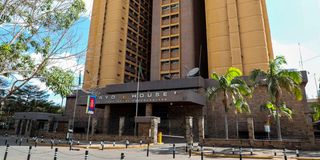Premium
Nyayo House is a crime scene, CS Kindiki now admits

Nyayo House, Nairobi. Interior CS Kithure Kindiki has been compelled by pressure from all corners of society to commit to cracking down on Nyayo House graft cartels.
What you need to know:
- CS Kindiki has been compelled by pressure from all corners of the society to commit to cracking down on Nyayo House graft cartels.
- Kindiki has acknowledged that corruption is deeply embedded at the immigration offices.
It was not the intention of anyone to name it Nyayo House when its building plans were approved in 1973. The government’s proposed name for it was Nairobi House.
But when construction started in 1979 —a year after Daniel arap Moi became President—by Laxmanbhai constructors at a cost of Sh220 million, Mr Moi’s excited handlers figured it out that it was cool if he named it after his political slogan—Nyayo.
When Mwai Kibaki became the third President after the 2002 General Election, the horrors of the Nyayo House torture chambers were laid bare.
In February 2003, the Kibaki administration ordered that the building be open for public visits and the then Nairobi Provincial Commissioner Cyrus Maina complied.
“Ironically, the Nyayo philosophy that informed the naming of the building had three pillars—peace, love and unity—but what became of the new Nyayo House was violence, hatred and disintegration. It was madness,” says former assistant minister Koigi wa Mwere.
Mr wa Mwere said that when the building was completed in 1983, “the five year old Nyayo regime had faced an attempted coup in 1982 and to prove to its enemies that it was well grounded and wouldn’t entertain a repeat of such, decided to use arbitrary arrests, torture and detentions without trial as its weapons.”
The building has two wings — north and south — and is 84 metres high with 27 floors at the junction of Nairobi’s Uhuru Highway and Kenyatta Avenue.
Architect Gideon Mulyungi had in 2003 revealed that the rooms that were initially designed to store cash and sensitive government documents were turned into torture chambers.
The Truth, Justice and Reconciliation Commission (TJRC) that the Kibaki regime had set up had listened to victims’ torture ordeals in the house and ordered for its secrets be made public.
It was when the secret doors were thrown wide open that Kenyans came to learn of 12 impregnable secret cubicles measuring about two-and-a-half metres long and two metres wide built with reinforced concrete to make them fire and sound proof.
Notable victims in the torture chambers included opposition leader Raila Odinga, Mr wa Mwere, former Imenti Central MP Gitobu Imanyara, former Githunguri MP Njehu Gatabaki and journalist Bedan Mbugua. Also in the list were George Anyona, Wahome Mutahi and legendary benga artiste Ochieng’ Kabaselleh.
Its dark past overshadows the fact that Nyayo House hosts various national government offices, including the immigration department. Owing to this, it’s among the busiest in the capital.
Nyayo House has found it difficult to shed off its nefarious history, continuing to plague Kenyans who have often complained of a deeply rooted culture of corruption in public offices.
Interior Cabinet Secretary Kithure Kindiki has been compelled by pressure from all corners of the society, including the National Assembly, to commit himself to cracking down on Nyayo House graft cartels.
Appearing before the National Assembly Regional Integration Committee last Thursday at Parliament Buildings, Prof Kindiki acknowledged that corruption was deeply embedded at the immigration offices.
"I will clean up Nyayo House once and for all. We will seal it off and declare it a crime scene. The corruption there has a direct relation with some of our ongoing problems, such as insecurity and terrorism,” said Prof Kindiki. He added that the passport backlog currently stands at 58,000.
Former Nairobi Provincial Commissioner Joseph Kaguthi said “shedding off the image of torture chambers has become a difficult task and the building should be renamed to something more appealing”. He suggested “Immigration House, Democracy House, Freedom House or other similar nice names”.





